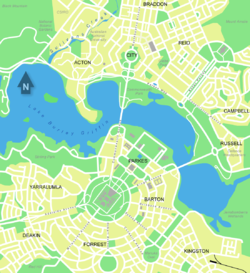User:Martyman/Sandbox/Canberra Geography
Geography[edit]

Canberra covers an area 805.6 km² and is located near the Brindabella Ranges, approximately 150 kilometres inland from Australia's east coast. It is located at altitudes that range from 550 m to 700 m above sea level. The highest point is Mt Ainslie which is one of several large hills that also include Mt. Mugga Mugga, Mt. Taylor and Black Mountain. The surrounding bushland and the original bushland that Canberra was built in is a mixture of eucalyptus savanna, scrubland, swamp and dry eucalyptus forests.
The Molonglo River flows through Canberra and has been dammed to form the body of water in the centre of the city called Lake Burley Griffin. The Molonglo then flows into the Murrumbidgee northwest of Canberra, which in turn flows along Canberra's south-western outskirts. The Queanbeyan River joins the Molonglo River at Oaks Estate just within the ACT. A number of creeks flow into the Molonglo and Murrumbidgee, such as Jerrabomberra and Yarralumla Creeks. Two of these creeks, the Ginninderra and Tuggeranong, have similarly been dammed to form Lakes Ginninderra and Tuggeranong. Until recently the Molonglo had a history of sometimes lethal floods; prior to the filling of Lake Burley Griffin, the area was a flood plain.
Climate[edit]
Because of its elevation and distance from the coast, Canberra has four distinct seasons, unlike many other Australian cities whose climates are moderated by the sea. Canberra is notorious for hot, dry summers, and cold winters with heavy fog and frequent frosts. According to the Australian Bureau of Meteorology, January is Canberra's hottest month, with a mean daily maximum temperature of 27.7 °C—the highest recorded maximum temperature was 42.2 °C on 1 February 1968.1 The mean daily maximum for July, the coldest month, is 11.2 °C and the mean daily minimum is −0.2 °C. The lowest recorded minimum temperature was −10.0 °C on 11 July 1971. In one out of approximately three winters snow falls in the city. Thunderstorms can occur between October and March, and annual rainfall is 629 mm, distributed fairly throughout the year.
Geology[edit]
Notable geological formations in the Canberra region include the Canberra Formation of ???, the Pittman Formation, Black Mountain Sandstone and State Circle Shale.
In the 1840s fossils of brachiopods and trilobites from the Silurian period where discovered at Woolshed Creek near Duntroon. At the time these where the oldest fossils discovered in Australia, though this record has now been far surpassed. [1]
The oldest rocks in the Canberra region date from the Ordovician around 480 Million Years Ago. During this period the Canberra region along with most of Southern Australia was part of the ocean floor. Formations from this period include the Black Mountain Sandstone formation and the Pittman Formation consisting largely of Quartz-rich sandstone, siltstone and shale. [2]
Urban structure[edit]

Canberra is a planned city that was originally designed by Walter Burley Griffin, a major American architect of the 20th century. The city centre is laid out on two perpendicular axes: a water axis stretching along Lake Burley Griffin, and a ceremonial land axis stretching from Parliament House on Capital Hill north-eastward to the Australian War Memorial at the foot of Mt Ainslie. The area known as the Parliamentary Triangle is formed by three of Burley Griffin's axes, stretching from Capital Hill along Commonwealth Avenue to the Civic Centre around City Hill, along Constitution Avenue to the Defence precinct on Russell Hill, and along Kings Avenue back to Capital Hill.
The urban areas of Canberra are divided into seven districts. In chronological order of development, they are:
- North Canberra, mostly settled in the 1920s and 30s, with expansion up to the 1960s, now 15 suburbs
- South Canberra, settled from the 1920s to 60s, 13 suburbs
- Woden, settled in 1963, 13 suburbs
- Belconnen, first settled in 1967, 25 suburbs
- Weston Creek, settled in 1969, 8 suburbs
- Tuggeranong, settled in 1974, 19 suburbs
- Gungahlin, settled in the early 1990s, 5 suburbs

Oaks Estate is a small suburb located near the ACT/NSW border; it is not part of any of the districts and has close ties with the neighbouring NSW town of Queanbeyan, of which it was originally a part, before the ACT was seperated from NSW in 1910. The North and South Canberra districts are based on Walter Burley Griffin's designs. The others are based on land contour design, each with a central shopping area known as the town centre. The districts are typically separated from each other by natural parklands—some 30 Canberra Nature Parks in all. Although the urban development of Canberra after World War II did not follow Burley Griffin's plan, strict urban planning rules still govern the development in the city.
Many of Canberra's suburbs are named after famous Australians, early settlers, or use Aboriginal words for their title. Street names typically follow a particular theme; for example, the streets of Duffy are named after Australian dams and weirs and the streets of Page are named after biologists and naturalists. Most foreign embassies and high commissions are located in the suburbs of Yarralumla, Deakin and O'Malley. Three suburbs are considered to be industrial districts: Fyshwick, Mitchell and Hume.
